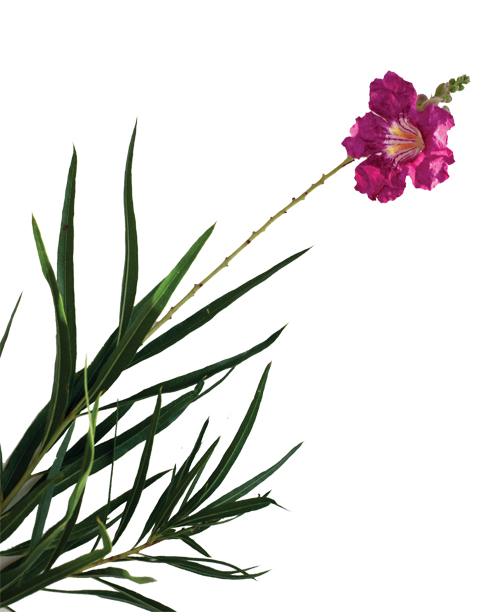Tidbits from the new Heritage Tree Tour
There are more than 40 species of trees on the TCU campus.

Wood from the Desert Willow, was used by Indians to craft their hunting bows. Tea can be made from its dried flowers and seedpods.
Tidbits from the new Heritage Tree Tour
There are more than 40 species of trees on the TCU campus.
The new Heritage Tree Tour debuts this fall on the TCU campus, highlighting 14 species. Maps of the trees’ locations, along with information about their growing conditions and characteristics, are available on the first floor of Sadler Hall. Here are a few fun facts about each of the 14 species:
1. American sycamore
platanus occidentalis
American Sycamores grow in full sun and can tolerate clay, loam, sand, acidic, alkaline, extended flooding and well-drained soil. However, they prefer moist soils that do not dry out. These trees can grow in places unsuitable to most plant growth.
Sycamore wood is resistant to splitting and, therefore, butchers prefer it for their cutting blocks.
Related Story: Branching Out —
The people behind the Heritage Tree Tour
2. Texas Live Oak
quercus virginiana
These majestic oaks that flank University Drive are an important source of tannins, which humans use to tan, or cure, leather hides. The trees use bitter-tasting tannins to protect themselves from animals looking for a snack. In Texas, a small grove of live oaks is known as a mott.
3. Possumhaw Holly
ilex decidua
The “possum” in possum haw comes from the fact that opossums like to hang out in the tree. The Celts hung the holly around their doorways to ward off evil and believed it provided shelter for good fairies.
4. Texas Mountain Laurel
sophora secundiflora
The tree sports hairy seedpods that are 8 inches long and ripen to reveal the inner, bright red seeds. These seeds are quite decorative and have been used to make necklaces, but they are also poisonous.
5. Desert Willow
chilopsis linearis
Wood from this tree, was used by Indians to craft their hunting bows. Tea can be made from its dried flowers and seedpods.
6. Cedar Elm
ulmus crassifolia
This tree is the only native Texas elm that flowers and sets seed in the fall. There’s no need to rake the small leaves—they compost nicely.
 7. Chaste Tree
7. Chaste Tree
vitex
This flowering tree’s berries were believed to help monks keep their vows of chastity, but the leaves were also believed to help infertility.
8. Chinkapin Oak
quercus muehlenbergii
Chinkapin oak is a durable hardwood prized for many types of construction. Its acorns are a good source of food for deer, turkey, and squirrels.
9. Caddo Maple
acer barbatum
Native to Oklahoma, this species is well adapted to hot summers and the drying winds of north Texas.
10. Pecan
carya illinoinensis
The state tree of Texas, the pecan tree contains antioxidants and plant sterols that reduce high cholesterol.
11. Crape myrtle
lagerstroemia
Imported from Asia, this species was introduced to the United States in 1790 by French botanist Andre Michaux in Charleston, S.C.
12. Chinese Pistachio
pistacia chinensi
The species is related to poison ivy and may cause dermatitis on sensitive skin. Native to Afghanistan, it was initially brought here strictly as an ornamental plant and seems to be naturalizing in local forests.
13. Lacebark Elm
ulmus parvifolia
Named for its decorative bark, this draught-tolerant species can survive in urban conditions, making this specimen well suited to its location in the visitor’s parking lot just south of the Tom Brown-Pete Wright Residential Community.
14. Yaupon
ilex vomitoria
The Algonquin tribe used leaves and stems to brew tea for male-only purification and unity rituals. Part of the ritual induced vomiting, which Europeans incorrectly thought was caused by the tea alone, giving the tree its name, “vomitoria.”
On the Web:
For information on the Great Tree Ring, go to brit.org
Download the Tree Map and a fact sheet
Related story: Branching Out: The people behind the Heritage Tree Tour

Your comments are welcome
Comments
Related Reading:
Campus News: Alma Matters
TCU’s Library Celebrates a Century
Uncover hidden gems of the academic hub, from vintage mechanics to modern masterpieces.
Campus News: Alma Matters
Infographic: TCU’s Shared Values
The Board of Trustees adopted four TCU values after considering input from more than 4,000 constituents.